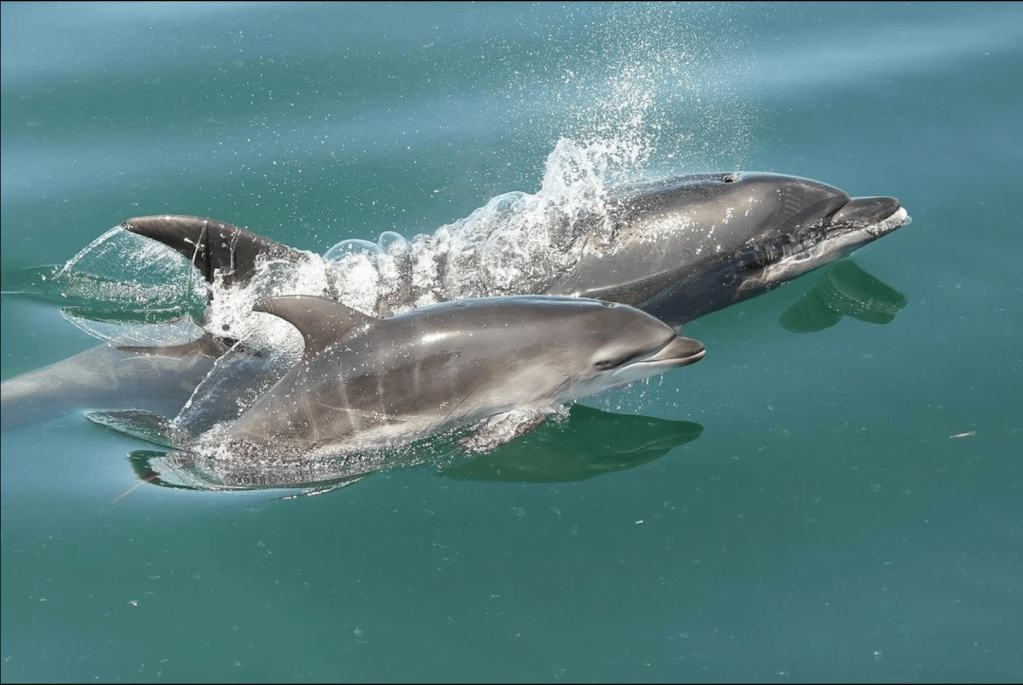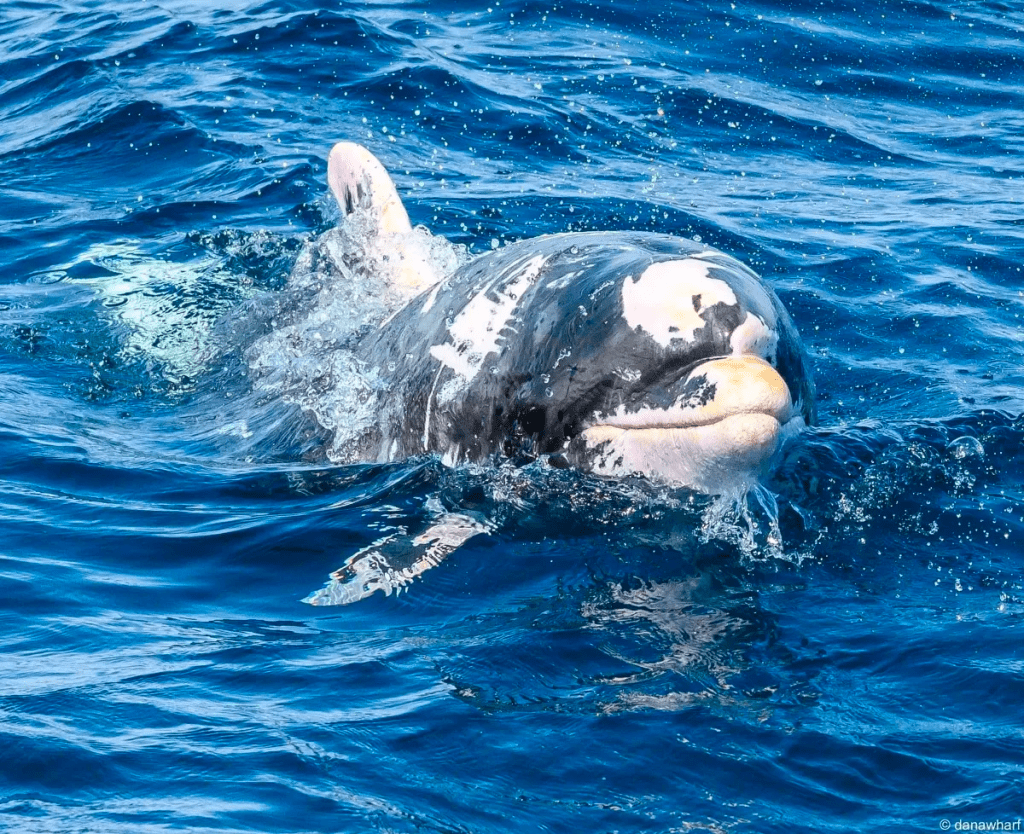Everything You Need to Know About Bottlenose Dolphins

Bottlenose dolphins, with their enchanting grace and intelligence, have captured the hearts of marine enthusiasts and scientists alike. These charismatic marine mammals, scientifically known as Tursiops truncatus, reign supreme as the most recognized and adored of all dolphins.

Bottlenose Dolphin Anatomy & Lifespan:
Bottlenose dolphins are the epitome of aquatic elegance. They boast a sleek, streamlined body designed for fast swimming, adorned with a beautiful grayish-blue skin tone. Bottlenose dolphins use their powerful tail flukes and curved dorsal fin for speed and stability in the water and their pectoral fins for steering and stopping. The iconic ‘bottlenose’ name is a tribute to their short, stubby rostrum, which houses a set of formidable teeth, allowing them to capture their prey with precision.
Adding to their unique physical attributes, bottlenose dolphins exhibit sexual dimorphism, with males typically being larger than females. Adult males can reach lengths of up to 8-12 feet and weigh up to 1,100 pounds, while adult females tend to be slightly smaller.
In the wild, bottlenose dolphins can live for up to 40-50 years, although the average lifespan is around 40 years. In captivity, they tend to live shorter lives due to stress and lack of natural stimuli.
Behavior and Social Structure:
Bottlenose dolphins live in groups called pods, which can range from a few individuals to over a hundred. These social structures are complex and can include alliances, subgroups, and even ‘friendships’.
Bottlenose dolphins are known for their high intelligence. They have been observed using tools, recognizing themselves in mirrors, and even learning sign language in captivity. These dolphins are renowned for their acrobatics, often leaping high out of the water and riding the bow waves created by boats. This joyful behavior is not merely for spectacle; it’s a form of communication and expression, a window into their world of camaraderie and delight.

Communication:
Bottlenose dolphins communicate using a combination of vocalizations and body language. Their communication is highly developed and serves various purposes within their social groups, known as pods. Here are some key ways in which bottlenose dolphins communicate:
- Clicks: Dolphins produce a series of rapid clicks, often referred to as echolocation clicks. These clicks are used for navigation, hunting prey, and determining the size, shape, and distance of objects in their environment. By emitting these clicks, they can create a mental map of their surroundings based on the echoes that bounce back to them.
- Whistles: Dolphins are known for their distinctive whistles, which are unique to each individual. These whistles are used for social communication and can serve as a way for dolphins to identify and locate each other. It’s believed that these signature whistles may function like names within the pod.
- Body Language: Dolphins use a variety of body movements to communicate with each other. These include leaps, slaps on the water surface with their tails or flippers, and other gestures. These movements can convey different messages, from playfulness to aggression or warning signals.
- Vocalizations: In addition to clicks and whistles, dolphins produce a range of other vocalizations, including burst-pulse sounds and squawks. These sounds are often associated with social interactions and can convey emotions or intent.
- Tactile Communication: Physical contact is another way dolphins communicate. They may rub against each other, nuzzle, or engage in gentle physical interactions as a form of bonding and socializing.
- Playful Behavior: Play is an essential part of dolphin communication and social bonding. Dolphins often engage in playful behaviors, such as leaping out of the water, riding waves, and play-fighting. These activities help strengthen social bonds within the pod.
- Communication Underwater: Dolphins are highly skilled at communicating underwater, where sound travels more efficiently than in the air. They use the ocean’s acoustic properties to transmit and receive messages effectively.
- Hunting Strategies: When hunting, dolphins coordinate their actions through a combination of clicks and body movements. This cooperation enables them to herd and corral prey effectively.

Habitat:
Bottlenose dolphins have a global presence, gracing the world’s warm and temperate seas with their presence. They are highly adaptable, thriving in diverse environments, from the open expanse of oceans to sheltered bays and coastal areas. Their flexibility allows them to explore habitats from the crystal-clear waters of the Bahamas to the rich ecosystems of the Pacific and Atlantic Oceans.
These dolphins’ preference for temperate and tropical waters often leads them to inhabit areas with consistent water temperatures ranging from 50°F to 90°F (10°C to 32°C). This adaptability ensures that they can thrive in a wide range of marine ecosystems.
Feeding Habits:
These marine marvels are opportunistic feeders, preying primarily on a delectable menu of fish, squid, and crustaceans. They usually dive for a few minutes at a time, with maximum dives reaching around 10 minutes and several hundred meters in depth. This adaptation allows them to hunt for fish and squid in deep waters. They are clever hunters, working cooperatively in pods to corral their prey and ensure a successful catch. Their communication skills come to the fore during these hunts, as they coordinate movements and communicate with each other to maximize their efficiency.
Bottlenose dolphins are known to exhibit varied hunting strategies. In some regions, they engage in “strand feeding,” a remarkable behavior where they corral fish towards the shore, often leaping onto the beach to catch their prey. This complex and unique feeding technique is a testament to their adaptability and intelligence.
Conservation:
While bottlenose dolphins aren’t currently listed as endangered, they face a host of threats in our changing world. Pollution, habitat degradation, entanglement in fishing gear, and human disturbance during recreational activities are significant concerns. Conservation efforts focus on implementing measures to safeguard their habitats, reducing pollution, and promoting responsible marine wildlife interactions.
One notable aspect of conservation is the recognition of different populations of bottlenose dolphins, each facing unique challenges. For example, coastal populations may be more vulnerable to human-induced threats due to their proximity to human activities, while offshore populations might face different challenges related to changes in their open-ocean environments.
Likelihood to See Bottlenose Dolphins in Dana Point, California:
Dana Point offers an excellent chance to encounter bottlenose dolphins. These charismatic dolphins are frequent visitors to the region’s rich waters. Our boat tours and excursions often provide unforgettable opportunities to witness these dolphins in their natural habitat, leaping and playing in the Pacific’s gentle waves.
In conclusion, bottlenose dolphins are the crown jewels of the marine world, celebrated for their allure, intelligence, and contribution to oceanic ecosystems. Whether you’re marveling at their sleek physicality, witnessing their playful leaps, or seeking to spot them off the coast of Dana Point, these magnificent creatures are a testament to the beauty and wonder of our oceans, reminding us of the importance of their conservation for generations to come.
